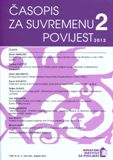Potrošačko društvo po američkom modelu (jedan pogled na jugoslavensku svakodnevicu šezdesetih)
Consumer Society According to the American Model (A Look at Everyday Life in Yugoslavia during the 1960s)
Author(s): Radina VučetićSubject(s): History
Published by: Hrvatski institut za povijest
Keywords: Americanization; consumer society; Zagreb Fair; supermarkets
Summary/Abstract: One of the particularities of Tito’s Yugoslavia was the rise of consumer society according to the American model. In conjunction with their propaganda, the Americans began to ship mass consumer goods to Yugoslavia, showcasing them at Zagreb’s Fair. Through the “export” of mass consumer goods, which most often were not available to citizens of Yugoslavia, but were looked at longingly by passersby at the Zagreb Fair, the concept of freedom was also exported. In this “export” of freedom, like in many cases with American propaganda, whether with regard to film, jazz, rock n’ roll, or kitchens and supermarkets, the message was not, of course, direct, but it had a long-lasting influence. It was the same with supermarkets, which brought about a modernization in buying experience, but also in the freedom of choice. This image of the rise of consumer society according to the American model is certainly not the only and most realistic picture of Yugoslavia in the 1950s and 1960s. At the same time that luxury goods were becoming available in the main streets of the large cities, in the capital there were rolling power outages and bread shortages. Such a Yugoslavia, a country of great contradictions, showed that the Yugoslavian version of the American dream was often painted not only in rose colours, but in gray and black tones.
Journal: Časopis za suvremenu povijest
- Issue Year: 44/2012
- Issue No: 2
- Page Range: 277-298
- Page Count: 22
- Language: Croatian

